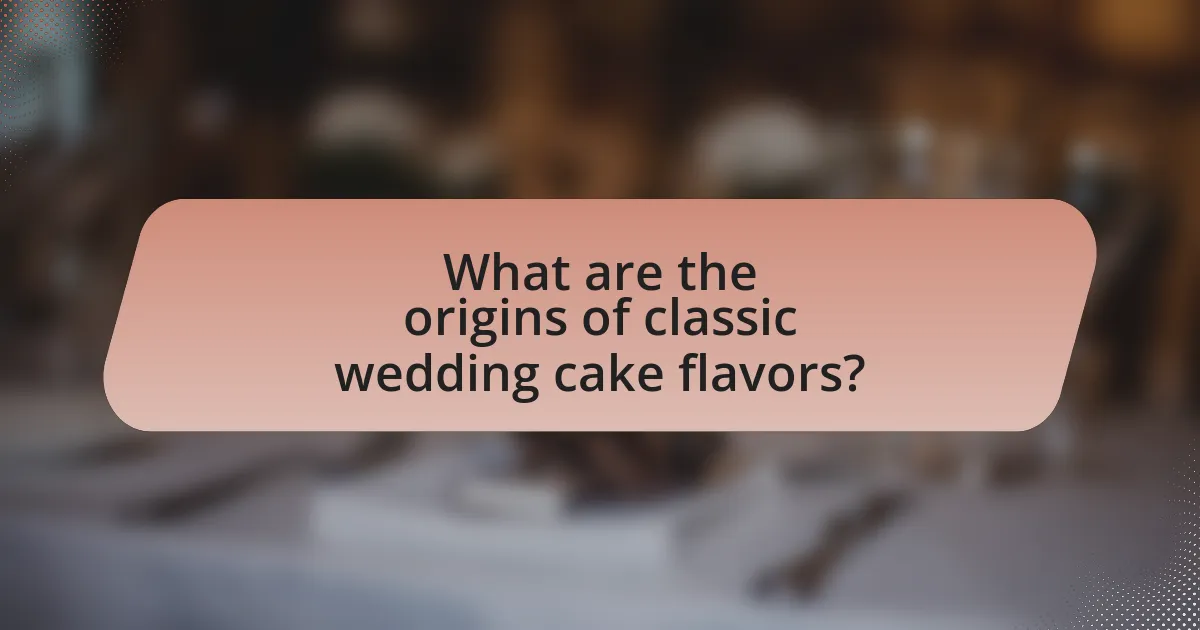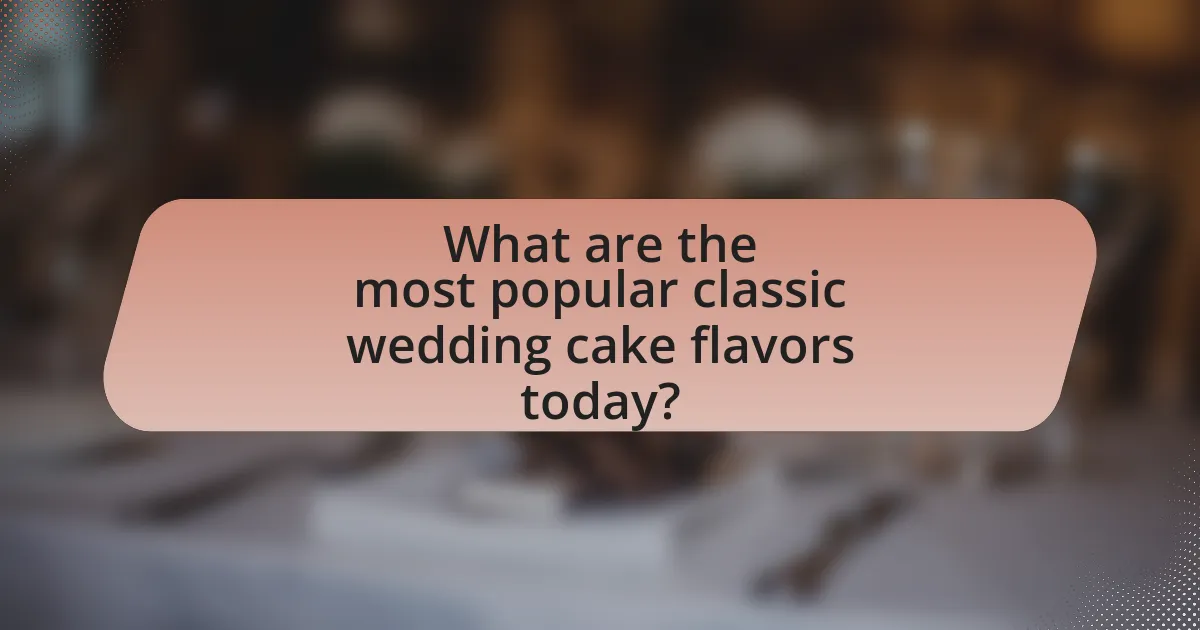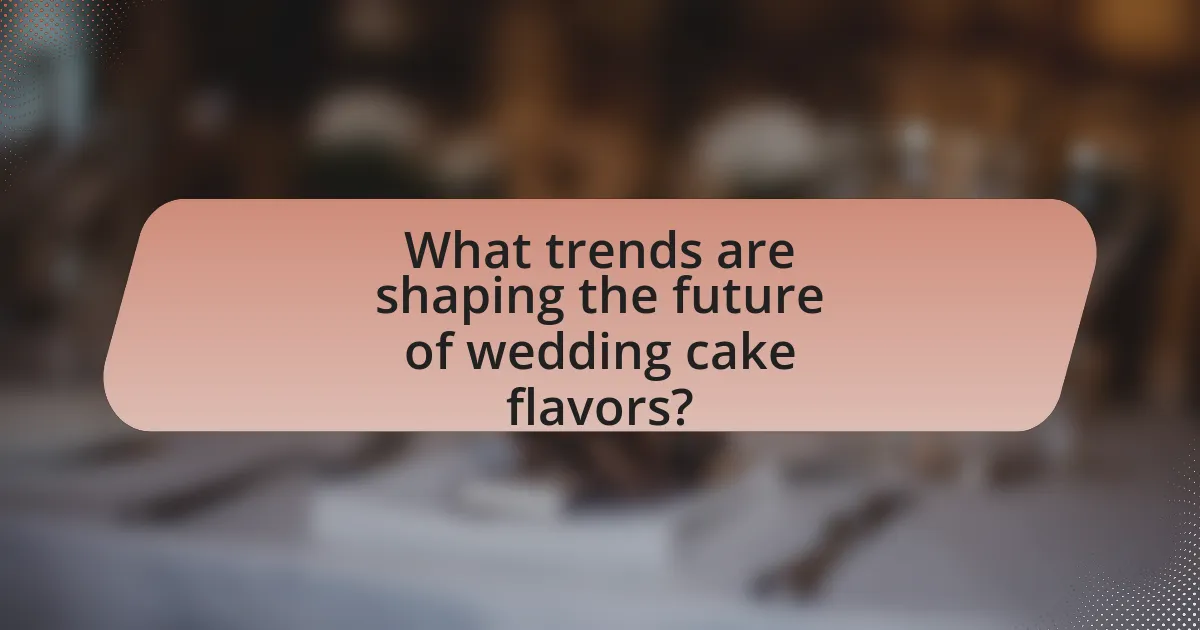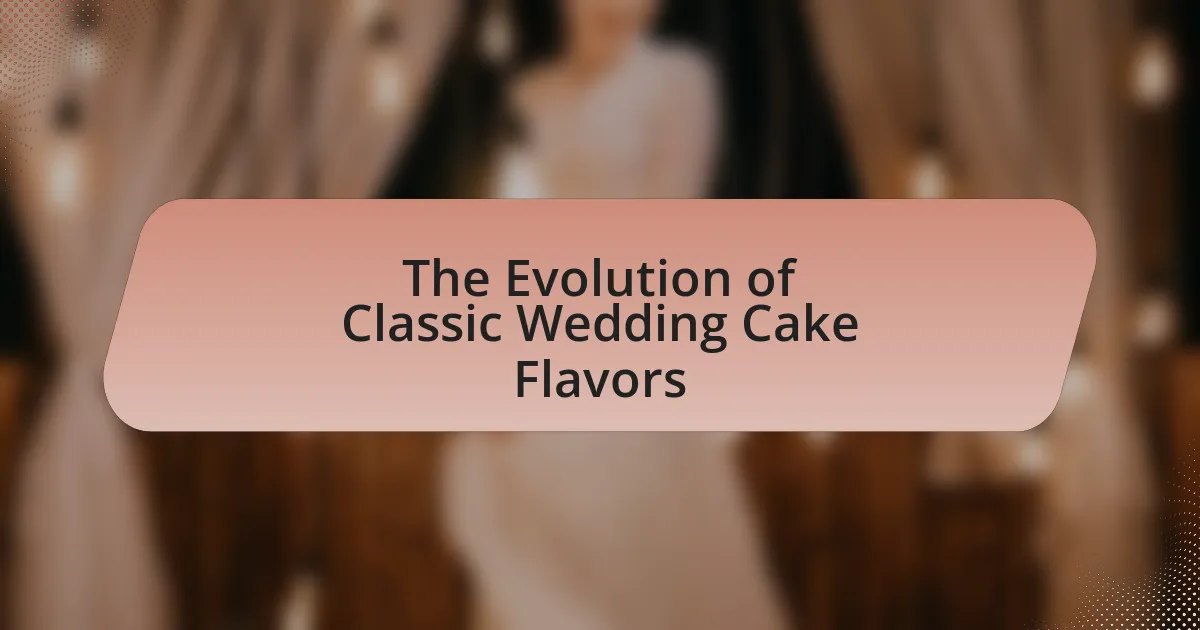The article explores the evolution of classic wedding cake flavors, tracing their origins from historical traditions and regional ingredients. It highlights how flavors like vanilla, chocolate, and fruit have developed over time, influenced by cultural practices and significant historical events. The piece also examines regional variations and the impact of dietary restrictions on flavor choices, while identifying popular flavors in North America and emerging trends in wedding cakes. Additionally, it provides insights into how couples can personalize their cake selections to reflect their tastes and experiences.

What are the origins of classic wedding cake flavors?
Classic wedding cake flavors, such as vanilla, chocolate, and fruit, originate from historical traditions and regional ingredients. Vanilla became popular in the 19th century due to the availability of vanilla beans from Mexico, while chocolate gained prominence in Europe after the introduction of cocoa in the 17th century. Fruit flavors, particularly citrus and berry, were often used in medieval wedding cakes, reflecting the seasonal availability of fresh produce. These flavors evolved as baking techniques improved and ingredients became more accessible, leading to the diverse range of classic wedding cake flavors enjoyed today.
How have traditional wedding cake flavors evolved over time?
Traditional wedding cake flavors have evolved from simple fruit and spice cakes to a diverse array of options, reflecting changing tastes and cultural influences. Historically, wedding cakes were often made with rich fruitcake or spice cake, symbolizing prosperity and fertility, as seen in 19th-century England. In the 20th century, the introduction of lighter cakes, such as vanilla and chocolate, became popular, influenced by American baking trends. Today, modern couples often choose unique flavors like red velvet, lemon, or even unconventional options like matcha or salted caramel, showcasing a blend of personal preferences and global culinary trends. This evolution highlights a shift towards personalization in wedding celebrations, moving away from traditional norms to embrace individual tastes.
What historical events influenced the development of wedding cake flavors?
The development of wedding cake flavors has been influenced by several historical events, notably the introduction of sugar in Europe during the Middle Ages. The Crusades (11th to 13th centuries) facilitated trade routes that brought sugar from the Middle East to Europe, allowing for sweeter cakes. Additionally, the Victorian era (1837-1901) saw the rise of elaborate wedding cakes, with flavors like fruitcake becoming popular due to the availability of dried fruits and spices from colonial trade. The post-World War II era also played a role, as advancements in baking technology and the mass production of ingredients led to a diversification of flavors, including chocolate and vanilla. These events collectively shaped the variety of wedding cake flavors we see today.
How did regional variations contribute to flavor diversity?
Regional variations significantly contributed to flavor diversity by introducing unique local ingredients and culinary traditions into wedding cake recipes. For instance, in the Southern United States, the use of pecans and peaches reflects regional agriculture, while in Italy, the incorporation of citrus and almond flavors showcases local produce and cultural influences. These distinct ingredients not only enhance the flavor profiles but also create a rich tapestry of tastes that represent the heritage and preferences of different regions. Historical practices, such as the use of spices in Middle Eastern wedding cakes, further illustrate how geographic and cultural contexts shape flavor diversity in wedding cakes.
What role do cultural traditions play in wedding cake flavors?
Cultural traditions significantly influence wedding cake flavors by dictating the ingredients and recipes used in different regions. For instance, in Italian weddings, traditional cakes like Panettone or Cassata are favored, reflecting the country’s culinary heritage. Similarly, in Indian weddings, flavors such as cardamom and saffron are prevalent, showcasing the cultural significance of these spices in Indian cuisine. These preferences are often rooted in historical practices and regional availability of ingredients, which shape the flavor profiles of wedding cakes across various cultures.
Which cultures have distinct wedding cake flavors?
Various cultures have distinct wedding cake flavors, including Italian, French, and Indian traditions. Italian weddings often feature a rich fruitcake known as “Torta di Nuziale,” which is soaked in liqueur and layered with cream. French weddings typically showcase a “Croquembouche,” a tower of cream-filled pastries bound with caramel, while Indian weddings frequently present a spiced cake flavored with cardamom and saffron, reflecting regional tastes. These unique flavors are deeply rooted in cultural practices and culinary heritage, showcasing the diversity of wedding celebrations worldwide.
How do cultural ingredients shape flavor profiles?
Cultural ingredients shape flavor profiles by introducing distinct tastes, aromas, and textures that reflect regional traditions and histories. For example, spices like cardamom in Indian cuisine or citrus zest in Mediterranean dishes contribute unique flavor notes that define the culinary identity of those cultures. Historical trade routes and agricultural practices have influenced the availability and use of these ingredients, leading to diverse flavor combinations in wedding cakes, such as the incorporation of matcha in Japanese celebrations or coconut in Caribbean festivities. These cultural elements not only enhance the sensory experience but also connect the dish to its cultural heritage, making flavor profiles a representation of cultural identity.

What are the most popular classic wedding cake flavors today?
The most popular classic wedding cake flavors today include vanilla, chocolate, and red velvet. Vanilla remains a timeless favorite due to its versatility and ability to pair well with various fillings and frostings. Chocolate is favored for its rich taste and is often chosen for couples who prefer a more decadent option. Red velvet, characterized by its unique color and subtle cocoa flavor, has gained popularity for its visual appeal and distinct taste. These flavors have consistently ranked high in wedding cake surveys and industry reports, reflecting their enduring appeal among couples planning their weddings.
How do flavor preferences vary by region?
Flavor preferences vary significantly by region due to cultural influences, local ingredients, and historical traditions. For example, in the Southern United States, flavors like red velvet and pecan are popular, reflecting local agricultural products and culinary history. In contrast, regions like New England favor flavors such as apple and spice, which are tied to local harvests and seasonal celebrations. Additionally, international influences shape preferences; for instance, Italian wedding cakes often feature flavors like almond and citrus, while Asian cultures may prefer matcha or coconut. These regional variations illustrate how geography and culture directly impact flavor choices in wedding cakes.
What are the top five wedding cake flavors in North America?
The top five wedding cake flavors in North America are vanilla, chocolate, red velvet, lemon, and almond. Vanilla remains the most popular choice due to its versatility and classic appeal, while chocolate is favored for its rich taste. Red velvet has gained popularity for its unique color and flavor profile, often paired with cream cheese frosting. Lemon offers a refreshing option, especially for spring and summer weddings, and almond provides a distinct flavor that many couples enjoy. These flavors reflect current trends and preferences in wedding cake selections across North America.
How do European wedding cake flavors differ from those in other regions?
European wedding cake flavors typically emphasize rich, traditional ingredients such as fruit, nuts, and spices, distinguishing them from other regions that may favor lighter or more innovative flavors. For instance, classic European cakes often feature flavors like almond, marzipan, and fruitcake, which are deeply rooted in cultural practices and historical recipes. In contrast, regions like North America may lean towards flavors such as chocolate, vanilla, or red velvet, reflecting contemporary trends and preferences. This divergence is supported by the historical significance of ingredients in European baking, where fruitcakes were often used in celebrations due to their longevity and richness, while other regions have adapted to modern tastes that prioritize lighter textures and flavors.
What are the key ingredients that define classic wedding cake flavors?
Classic wedding cake flavors are primarily defined by ingredients such as vanilla, almond extract, lemon zest, and butter. These ingredients create a rich and aromatic base that is traditionally complemented by fillings like fruit preserves, chocolate ganache, or cream cheese frosting. The use of vanilla and almond extracts dates back to early cake recipes, while lemon zest adds a refreshing brightness, enhancing the overall flavor profile. The combination of these ingredients has been a staple in wedding cakes, reflecting both historical preferences and contemporary tastes.
How do different types of flour affect flavor and texture?
Different types of flour significantly affect the flavor and texture of baked goods. For instance, all-purpose flour provides a balanced texture and mild flavor, making it versatile for various recipes. Cake flour, with its lower protein content, results in a tender, soft crumb, enhancing the lightness of cakes. Bread flour, higher in protein, contributes to a chewier texture and a more robust flavor, ideal for yeast-based products. Whole wheat flour adds a nutty flavor and denser texture due to the inclusion of the bran and germ, which also increases nutritional value. These variations in protein content and processing methods directly influence the final product’s taste and mouthfeel, as supported by baking science principles.
What role do fillings and frostings play in flavor enhancement?
Fillings and frostings significantly enhance flavor by adding complementary and contrasting tastes to the cake. Fillings, such as fruit preserves or chocolate ganache, introduce moisture and richness, while frostings, like buttercream or cream cheese, provide sweetness and texture. This combination creates a multi-dimensional flavor experience, making each bite more enjoyable. For instance, a vanilla cake with raspberry filling and cream cheese frosting balances sweetness with tartness, enhancing overall flavor complexity.

What trends are shaping the future of wedding cake flavors?
Current trends shaping the future of wedding cake flavors include a shift towards unique and personalized options, such as exotic fruits, savory elements, and global flavors. This evolution reflects a growing desire among couples to move away from traditional vanilla and chocolate cakes, opting instead for combinations like lavender lemon, matcha green tea, and salted caramel. Additionally, the incorporation of dietary preferences, such as gluten-free and vegan options, is becoming increasingly popular, catering to diverse guest needs. According to a survey by The Knot, 40% of couples are choosing non-traditional flavors, indicating a significant shift in consumer preferences towards more adventurous and customized cake experiences.
How are modern tastes influencing traditional flavors?
Modern tastes are influencing traditional flavors by incorporating contemporary ingredients and flavor profiles that reflect current culinary trends. For instance, the rise of health-conscious eating has led to the integration of alternative sweeteners, such as agave or coconut sugar, into classic wedding cake recipes, replacing traditional refined sugars. Additionally, flavors like matcha, lavender, and salted caramel have gained popularity, prompting bakers to experiment with these modern tastes in traditional cakes, thereby creating a fusion of old and new. This shift is supported by consumer demand for unique and personalized experiences, as evidenced by a 2021 survey from The Knot, which indicated that 40% of couples sought non-traditional flavors for their wedding cakes.
What innovative flavor combinations are emerging in wedding cakes?
Innovative flavor combinations emerging in wedding cakes include lavender and lemon, chocolate and chili, and matcha and white chocolate. These pairings reflect a trend towards unique and sophisticated tastes, moving away from traditional vanilla and chocolate options. For instance, lavender and lemon provide a floral and citrusy balance, while chocolate and chili introduce a spicy kick that enhances the richness of the cake. Matcha and white chocolate combine earthy and sweet flavors, appealing to modern palates seeking novelty. These combinations are increasingly popular among couples looking to personalize their wedding celebrations with distinctive culinary experiences.
How are dietary restrictions impacting flavor choices?
Dietary restrictions significantly influence flavor choices in wedding cakes by necessitating the adaptation of traditional recipes to accommodate various dietary needs. For instance, gluten-free, vegan, and nut-free options have become increasingly popular as more couples seek to include guests with specific dietary requirements. Research indicates that approximately 30% of the population follows some form of dietary restriction, prompting bakers to innovate flavors that align with these needs while still appealing to a broader audience. This shift has led to the emergence of alternative flavors such as almond, coconut, and fruit-based options, which cater to those avoiding gluten or animal products, thereby expanding the flavor palette available for wedding cakes.
What are some tips for choosing the perfect wedding cake flavor?
To choose the perfect wedding cake flavor, consider the preferences of both partners and the overall theme of the wedding. Couples should sample various flavors during tastings to identify their favorites, ensuring they select options that resonate with their taste buds. Additionally, incorporating seasonal ingredients can enhance freshness and appeal; for example, using berries in summer or spices in fall can create a delightful experience. It’s also beneficial to consider the cake’s texture and how it pairs with frosting and fillings, as this can significantly impact the overall flavor profile. Ultimately, aligning the cake flavor with the couple’s personal story or shared experiences can make the choice even more meaningful.
How can couples incorporate personal tastes into their wedding cake?
Couples can incorporate personal tastes into their wedding cake by selecting flavors, fillings, and designs that reflect their individual preferences and shared experiences. For instance, they might choose a cake flavor that is significant to their relationship, such as a favorite dessert from their first date or a family recipe. Additionally, couples can customize fillings and frostings to include unique ingredients that resonate with their tastes, like exotic fruits or spices. They can also opt for themed decorations that represent their hobbies or interests, such as floral designs for nature lovers or geometric patterns for modern aesthetics. This personalization not only enhances the cake’s appeal but also creates a memorable centerpiece that tells their story.
What factors should be considered when selecting a wedding cake flavor?
When selecting a wedding cake flavor, key factors include the couple’s personal preferences, guest dietary restrictions, and seasonal availability of ingredients. Personal preferences ensure that the cake reflects the couple’s tastes, while considering guest dietary restrictions, such as allergies or vegan options, ensures inclusivity. Additionally, choosing flavors that align with seasonal ingredients can enhance freshness and taste, as certain flavors may be more vibrant and appealing when made with in-season produce.
